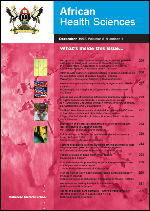
|
African Health Sciences
Makerere University Medical School
ISSN: 1680-6905
EISSN: 1680-6905
Vol. 18, No. 2, 2018, pp. 218-226
|
 Bioline Code: hs18029
Bioline Code: hs18029
Full paper language: English
Document type: Study
Document available free of charge
|
|
|
African Health Sciences, Vol. 18, No. 2, 2018, pp. 218-226
| en |
Peer pressure and home environment as predictors of disruptive and risky sexual behaviours of secondary school adolescents
Adimora, Dorothy Ebere; Akaneme, Immaculata Nwakaego & Aye, Eucharia Nchedo
Abstract
Background: Not much is understood about the predictive power of home environment and peer pressure on disruptive behaviour and risky sexual behaviour of adolescents.
Objectives: The study investigated the predictive power of home environment and peer pressure on disruptive behaviour and
risky sexual behaviour of adolescents in secondary school class two in Enugu State, Nigeria. Four research questions and four
null hypotheses guided the study.
Methods: The design was a cross sectional survey of correlational study. The study was carried out in the six Education zones in
Enugu State, Nigeria. The population was all the 31,680 senior secondary class two (SS11) adolescents in 285 secondary schools
in Enugu State, Nigeria in 2015/2016 academic session. The instruments for data collection were an observation schedule, an
interview session and a structured questionnaire of four clusters. To determine the R-squares for each regression model, a multivariate multiple regression model was conducted using “MANOVA” and “MVREG”.
Results: This study indicates adolescents who reported their home environments to be stimulated displayed compliant behavior
and none or lowered risky sexual behaviour, whilst those with chaotic and unstimulated home environment displayed disruptive
behaviours. It was found that adolescents who show a heightened sensitivity to positive peer pressure demonstrated compliant
and no or lowered risky sexual behavior whilst, those that are engaged with negative peer pressure strongly exhibit disruptive
and risky sexual behaviour.
Conclusion: Unstimulated home environment and negative peer group could consequently interact to predispose these adolescents to disruptive behaviour and risky sexual behaviour.
Keywords
Home; peer group; disruptive; behaviour; adolescents.
|
| |
© Copyright 2018 - Adimora et al.
|
|
